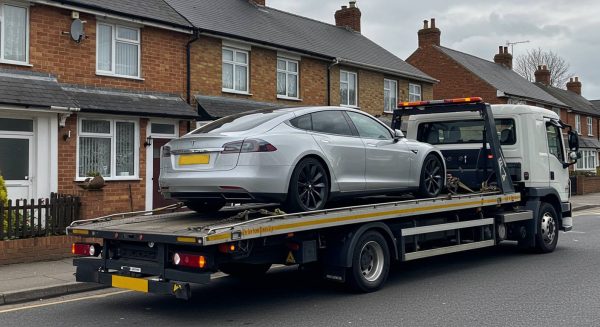As electric vehicles (EVs) and electric hybrid cars become increasingly common on UK roads, the vehicle recovery industry is adapting its practices and procedures. While many aspects of EV recovery remain similar to conventional vehicle recovery, there are important additional safety and technical considerations when dealing with broken down or damaged electric and hybrid vehicles.
Safety First
The most critical consideration in EV recovery is high-voltage safety. Modern electric and hybrid vehicles typically operate with battery systems between 400 and 800 volts. Recovery operators need specific training to safely handle EVs, particularly in accident scenarios where battery packs may be damaged. The powertrain must be fully isolated before any recovery work begins, and operators should wear appropriate personal protective equipment, including voltage-rated gloves, when necessary.
Vehicle Identification
Identifying an EV or hybrid isn’t always straightforward, especially after an accident. While many EVs have distinctive badges or styling, some are visually similar to their combustion engine counterparts. EV recovery specialists should look for identifying features like charging ports, blue-tinted badges, or “EV” markings. Most manufacturers now provide emergency response guides specific to their electric vehicle models, which recovery operators should familiarise themselves with.

Recovery Methods
Standard recovery methods like spectacle lifts and flatbeds remain suitable for most electric hybrid car vehicle recovery situations. However, operators must be aware of battery pack locations to avoid damage during lifting. Most EVs have reinforced battery casings and designated lifting points clearly marked. Wheeled recovery using a dolly system may not be suitable for some EVs due to regenerative braking systems that can make wheels difficult to rotate when unpowered.
Charging Considerations
A common reason for EV recovery is simple battery depletion. While a combustion engine vehicle can be quickly refuelled at the roadside, EVs require proper charging facilities. Recovery operators should be equipped with mobile charging solutions or have arrangements with charging networks. However, many EVs will need transportation to a charging point or the owner’s destination rather than just a quick roadside fix.
Specialist Equipment
Recovery vehicles themselves are evolving to meet the needs of electric vehicle recovery. Some operators now use electric recovery vehicles, particularly in urban areas with low-emission zones. These vehicles require their own specialist considerations around range and charging but can be particularly suitable for recovering EVs since they avoid the risk of fuel spillage around damaged electrical systems.
Fire Risk Management
While EV fires are statistically rare, thermal runaway in damaged lithium-ion batteries requires specific firefighting approaches. EV recovery specialists should carry appropriate fire suppression equipment and be trained in its use. Some operators now use specially designed thermal blankets that can contain battery fires during transportation.
Driver Communication
Recovery operators need to communicate effectively with EV drivers who may be experiencing their first breakdown. Many EV-specific issues can be resolved through the vehicle’s own diagnostic systems or smartphone apps, and operators should be familiar with common troubleshooting steps for major electric vehicle brands.
Training Requirements
The Institute of Vehicle Recovery now includes EV-specific modules in its training programs, reflecting the importance of proper preparation for electric vehicle recovery. This includes understanding electrical isolation procedures, identifying different EV types, and using appropriate recovery methods. Training in how to drive electric vehicles is helpful so that tow truck drivers understand their idiosyncrasies.
Future Considerations
As EV technology continues to evolve, recovery methods will need to adapt. The introduction of solid-state batteries, wireless charging systems, and other innovations may require new approaches to safe vehicle recovery. EV recovery specialists should stay informed about technological developments and regularly update their training and equipment.
By understanding and preparing for these considerations, recovery operators can ensure they provide safe and effective service for the growing number of EVs on UK roads. Both operators and drivers can have confidence that EVs can be recovered as safely and efficiently as conventional vehicles when proper procedures are followed.
